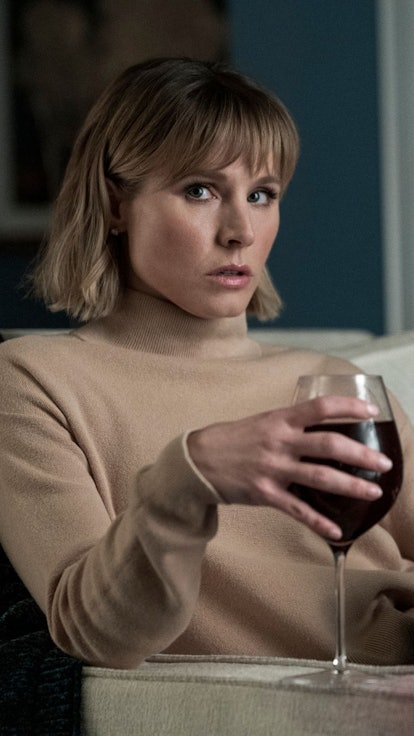What hath Gillian Flynn's Gone Girl wrought now, you ask? Netflix's strange, but mostly entertaining The Woman in the House Across the Street from the Girl Next Door (which will henceforth be known as The Woman in the House, because come on). To be fair to Flynn, I can't lay all of the blame for this madcap domestic thriller parody at her feet. After all, she didn't invent the genre — it's been around at least since the days of Daphne du Maurier's Rebecca — but she is responsible for it taking over the publishing industry and Hollywood since her novel's original release in 2012.
Since Gone Girl became a blockbuster success both within the book world and on the big screen, dozens upon dozens of thrillers about suburban women (and their big city counterparts) being caught up in murder mysteries have flooded the market. And while every now and then one of them will stand out thanks to a truly shocking twist or an unexpected lead character (my kingdom for a reliable narrator), for the most part, the stories all hit the same beats. That's especially true when it comes to the works of controversial author AJ Finn, who wrote The Woman in the Window, which is parodied hard in The Woman in the House.
From the copious amounts of wine Anna drinks to her ultra-specific rain phobia, the series is chock full of references to the greatest hits of the domestic thriller genre, but you'll also find nods to classic cinema and everyone's favorite women in peril channel, Lifetime, too. Read on for five of the most notable influences on this wild domestic thriller mashup of a series. (And warning: Spoilers!)
1.The Woman in the Window
If you've seen the Netflix original film version of The Woman in the Window or read the book on which it was based, then you likely saw the big twist in The Woman in the House coming early on. After all, location aside, the show more or less has the exact same plot as the Amy Adams film. Here are just a few of the similarities between the stories:
- The main characters are both named Anna.
- Anna from The Woman in the Window is agoraphobic, while Anna from The Woman in the House is ombrophobic.
- Both women see and have conversations with their dead daughters — and blame themselves for their deaths.
- The Annas are unreliable narrators who regularly mix wine and prescription medications, which leads to hallucinations.
- They both witness murders from across the street that no one believes actually happened.
- It's ultimately revealed that the child in the family across the street is a serial killer who is responsible for the murder, although in The Woman in the Window the character is a teen, not a 9-year-old.
- Both women's stories end with them overcoming their phobias and starting fresh.
2. The Girl on the Train
The Girl on the Train by Paula Hawkins is another touchstone for the show, although it largely plays off the plot of the book and the Emily Blunt movie to produce red herrings along the way. Most notably, the estranged husband and proverbial man across the street is gaslighting the main character, Rachel. In The Woman in the House, neither Neil or Douglas are violent, but Anna definitely suspects Neil is for a little while.
- Both protagonists are alcoholics who continue their daily routines of riding the train and doing the school run, respectively, despite Rachel having lost her job and Anna having lost her daughter.
- They both end up accused of a murder they didn't commit.
- Both characters take the murder investigation into their own hands after being ignored by the police.
- Anna and Rachel are unreliable narrators who suffer from blackouts and lost memories.
- The movie ends with a visit to a grave, albeit one lacking a pithy epitaph.
- The fantasy sequences Anna has of Neil being violent are very similar to the actual behavior of Rachel's abusive/murderous ex in The Girl on the Train.
3. Lifetime Movies
Before domestic thrillers became all the rage in the book world, Lifetime movies were serving up a steady stream of women in peril movies where the woman in question generally saves herself. The Woman in the House gives off some major Lifetime vibes, including but not limited to: Anna's "good girl" persona, the stilted/overwrought dialogue, the whole Buell subplot (there's always a creepy, yet kindhearted red herring lurking about), Anna taking on the investigation herself, the showdown with Emma in the end, and the neighbors with a secret moving in across the street. Add in the 2016 classic Mommy's Little Girl, and you can find enough Lifetime tropes to fill a Bingo card.
4. The Bad Seed
Yes, the Emma reveal is reminiscent of the big twist in The Woman in the Window, but it's also an obvious nod to the 1956 cult classic The Bad Seed, about a murderous little blond-haired moppet who goes on a killing spree for the most arbitrary of reasons. Incidentally, Lifetime remade the movie in 2018.
5. Rear Window
From the manner in which the first two episodes are filmed to the general set up of Anna witnessing a murder next-door and no one believing her, the show owes a great debt to Alfred Hitchcock's Rear Window. The beloved 1954 thriller was turning bored peeping toms into amateur detectives way before it was cool.
No matter how you ultimately feel about The Woman in the House, you have to admit the show's thriller parody game is strong.
Image: Colleen E. Hayes/Netflix; Netflix




